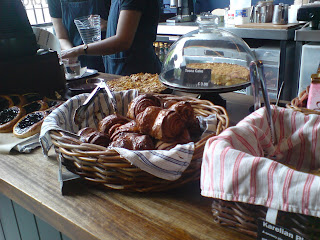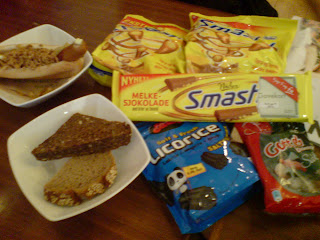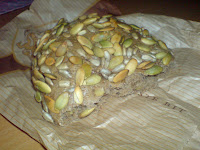Cinnamon buns in the Nordic Bakery (see below).
Huzzah, the Spy has made it back to Blighty! The bluebirds are cartwheeling over the white cliffs of Dover, Winston Churchill and Sherlock Holmes are dancing the conga down the street, and Queen Elizabeth I is doing a victory streak across the rugby pitch with nothing to preserve her modesty but a St. George's Cross flag. And to celebrate? A Saturday breakfast scone The Orchard in Grantchester (fear not, a long-overdue 'best scone' post is clattering about in the Spy's brain), followed the next day by a tramp along the river to Fen Ditton and a plate of fish and chips from The Sea Tree down on Mill Road.
A few days later, he found himself in London for a working-lunch with fellow Spy and volcano-strandee Agent Gherkin. With some serious Norwegian food withdrawal symptoms, they were prompted to scurry over to the Scandinavian Kitchen on Great Titchfield Street and stock up on proper Scandinavian hot dogs, Smash chocolate (salty tortillas covered in chocolate: pure unadulterated heaven) and salted liquorice, before heading over to the Nordic Bakery on Golden Square for some serious cinnamon buns (the best in London, dear reader) and a strong cup of Finnish coffee.
Clockwise from top right: a mighty collection of smash, salted liquorice, rye bread and pølse (hot dog).
Cinnamon bun (forward), orange-and-poppy-seed cake (back).
However, most importantly, he had made it back onto this beloved and daft little island in time for a particularly important family birthday, and thus he comes to the real purpose for this post. Back in the mists of time, a great-great-great Spy ancestor held the key to birthday cake heaven, with a dense, heavy chocolate beast that would be baked for any such celebration. She continued to churn out these wonderful creations despite the fact that in every other respect she had become knicker-boilingly doddery; testament to the enduring importance of culinary family traditions that are beaten into children as soon as they can hold a wooden spoon. The Spy was hardly a twinkle in a milkman's eye at the time of this venerable lady's demise, and yet he vividly remembers her cakes perched upon her kitchen table on top of a red-and-white checked tablecloth, although said tablecloth, table and cake towered above him on account of his diminutive stature.
Confused, dear reader? Revolted, perhaps? Titillated, no doubt? Read on...
This is daddy in the Holy Trinity of Spy family birthday cakes , and in order to preserve the recipe for posterity, it must be shared with the world. On this particular occasion, the decoration took the form of a portrait of the Birthday Boy himself, with chunks of the aforementioned tortilla Smash for his noble and sagacious beard (note the cunning blending of culinary cultures: the Spy will not be caught napping) and chocolate sprinkles for his unruly (but no less noble) mop of hair. A generation or two ahead of the Spy, this esteemed gentleman also remembers this cake being made for him when he was a (marginally) less hairy, wee slip of a boy. Finally, the best tip for this recipe: make it badly. The less-risen, the denser and stodgier, the better. No fluffiness, no delicacy, no skill. Hell, this is a shoddy, occasionally bearded monstrosity very close to the Spy's heart, straight from the hills and moors of northern England.
Nana's Chocolate Cake:
Cake:
7 oz self-raising flour
1-2 oz cocoa powder
8 oz caster sugar
1/2 tsp salt
4 oz margarine (Nana used 'Stork')
2 eggs, beaten
5 tablespoons evaporated milk
5 tablespoons water
1 tsp vanilla essence
Icing:
2 1/2 oz margarine, melted
2 oz cocoa
9 oz icing sugar
3 tablespoons milk, heated
1 tsp vanilla essence
Pre-heat oven 180 C, grease and flour two 8 inch cake tins
Sieve flour, sugar, salt and cocoa into bowl
Rub in margarine
Stir in eggs, vanilla essence and liquids
Beat well
Divide between tins and bake for 30-35 mins until skewer/knife comes out clean
Leave for 5 mins in tin, then cool on wire rack
To make the icing, sieve sugar and cocoa, add liquids, beat until smooth
Sandwich cake together with half the icing, and spread the other half on top
















































